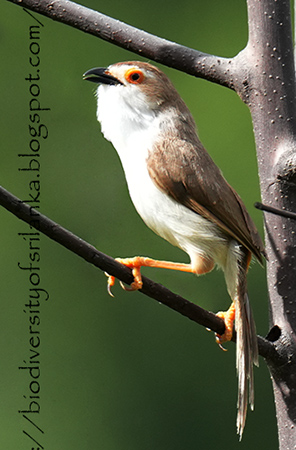Pages
- Home
- Flora of Sri Lanka
- Dragonflies & Damselflies of Sri Lanka
- Butterflies of Sri Lanka
- Freshwater Fishes of of Sri Lanka
- Amphibians of Sri Lanka
- Snakes of Sri Lanka
- Tetrapod Reptiles of Sri Lanka
- Mammals of Sri Lanka
- Resident Birds of Sri Lanka
- Migrant Birds of Sri Lanka
- Vagrant Birds of Sri Lanka
- Status Uncertain or Doubtful Birds of Sri Lanka
Monday, November 27, 2023
Olive Keelback/දිය වර්ණයා/කඩොලා [Diya warnaya/Kadola] (Atretium schistosum)
A non-venomous aquatic snake inhabiting damp places near water bodies such as streams, ponds, wells, paddy fields as well as brackish habitats of mangroves and lagoons from lowlands to about 1000m elevations. It active during the day time and feeds mainly on frogs and fish. Also takes tadpole, aquatic insects, mosquito larva and crabs and other crustaceans. Olive Keelback is a good swimmer and diver which also climbs low bushes near water. It is an oviparous snake breeding during the rainy season from December to April. It lays 10 - 30 eggs inside crevices, under logs or in leaf litter among stones near water.
Sunday, November 26, 2023
Hulodes caranea
Wingspan - 84 - 90 mm
References -
- Jayawardana, N.C. (2020) A Handbook to the Moths of Sri Lanka Vol. 01
- https://www.inaturalist.org/taxa/153462-Hulodes-caranea
Saturday, November 25, 2023
Yellow-eyed Babbler (Chrysomma sinense)
Uncommon and local breeding resident of grasslands and scrublands from lowlands to mid hills. Much common in the dry lowlands and rare in the wet zone and hills. It lives as pairs or as small flocks, skulking mostly in dense shrubbery, feeding mainly on insects. But towards the evening they often perch on twigs in a open place and utter its loud call. Main breeding season lasts from February to May. The nest is a deep cup made out of grass-blades bound with cobwebs, which fastened to several stems of long Mana type grasses, where it lays three or four eggs.
Friday, November 24, 2023
Mecardonia procumbens
An introduced decumbent or erect herb grows on open, frequently wet places such as margins of paddy fields. Native to tropical and sub tropical America. A recent introduction to Sri Lanka and naturalized in some places in the Knuckles Range.
Thursday, November 23, 2023
වී කුරුල්ලා/පිට සුදු වී කුරුල්ලා/නිතඹ සුදු වී කුරුල්ලා (Lonchura striata)
පහත රට ප්රදේශ වල සිට කඳුකරයේ මධ්යම උස් මට්ටම් දක්වා ගෙවතු, කුඹුරු, වනාන්තර, විවෘත වනලැහැබ්, වගාබිම් වල මෙන්ම ලඳු කැලෑ වලත් සුලභ ලෙස හමුවන දේශීය පක්ෂියෙකි. ජෝඩු වශයෙන් හෝ කුඩා රංචු වශයෙන් දිවි ගෙවන මෙම වී කුරුල්ලා වී ඇතුලු බොහෝ තණකොල විශේෂ වල බීජ ආහාරයට ගනී. පෙබරවාරි සිට මැයි දක්වා කාලයේ ප්රධාන වශයෙන් අභිජනනයේ යෙදෙන මුත් බොහෝවිට වසර පුරාම පාහේ පැටවුන් බෝ කිරීම සිදු කරයි. එක් පැත්තකින් ඇතුළු වීමට විවරයක් සහිතව ගසක් හෝ පඳුරක් මත තණකොල පත්ර උපයෝගි කරගනිමින් තනන බෝලයක හැඩැති කූඩුවක බිත්තර 4 ත් 6 ත් අතර ප්රමාණයක් දමා අභිජනනය සිදු කරයි.
English Post >>
Wednesday, November 22, 2023
පොල්කිච්චා (Copsychus saularis)
සියළුම දේශගුණික කලාප වල පිහිටි ගෙවතු, වගා බිම් සහ ලඳු කැලෑ වල ඉතාමත් සුලභ දේශීය පක්ෂියෙකි. එහෙත් ඝන වනාන්තර වල දැකිය නොහැක. තනි පක්ෂීන් ලෙසින් හෝ ජෝඩු වශයෙන් හැසිරෙමින් ප්රධාන වශයෙන් පොළොව මත සිටින කෘමීන් ගොදුරු කරගන්නා පොල්කිච්චා ඊට අමතරව නිවාස වලින් අහක දමන බත්, පාන් වැනි දේද ආහාරයට ගනී. ගොම්මන් වේලාව ගෙවුන පසුව පවා ක්රියාශීලීව හැසිරෙන මෙම පක්ෂියාගේ පිරිමි කුරුල්ලා උස ගසක් මත හෝ ලාම්පු කණුවක් මත සිට නගන වසම් වෙන් කරගැනීමේ නාදය උදෑසන හිරු නැග ඒමටත් පෙර සිටම ඇසිය හැක. ඇතැම් විට පිරිමි පක්ෂීන් අතර දරුණු සටන් ඇතිවන ආකාරද නිරීක්ෂණය කර ඇත. වසරේ මාර්තු සිට සැප්තැම්බර් දක්වා කාලයේ ගසක බෙනයක් තුල තණකොල සහ කෙඳි වර්ග එකතු කර සදන කූඩුවක බිත්තර දෙකක් හෝ තුනක් දමා අභිජනනය කරයි.
English Post >>
Monday, November 13, 2023
Rufous Bellied Eagle/බඩරතු රාජාලියා/කුසරත් සිළුකුස්සා [Badaratu Rajaliya/Kusarath Silukussa ] (Lophotriorchis kienerii)
Rather rare breeding resident of forests and such well-wooded areas throughout the country. It lives as solitary birds or as pairs. Rufous Bellied Eagle feeds mainly on birds, mostly doves and pigeons, which it capture on the wing by stooping from a height, with wings nearly closed and winglets elevated, rather like falcons. Also takes small mammals and reptiles. The breeding season lasts from December to March and it build a nest, a large pile of sticks lined with green leaves placed in a tree and lays a single egg.
Sunday, November 12, 2023
කහ කොණ්ඩයා/බැම කහ ගුලූගුඩුවා (Actritillas indica)
පහත රට තෙත් කලාපයේ වනාන්තර සහ එවැනි මනාව ගහ කොළ සහිත වෙනත් ස්ථාන වලත්, වනාන්තර අවට ගෙවතු වලත් වියලි කලාපයේ ඝන වනාන්තර වලත් ස්ථානීය වශයෙන් සුලභ දේශීය පක්ෂියෙකි. මුහුදු මට්ටමේ සිට මීටර 1500 දක්වා කඳුකරයේ හමුවන මුත් දිවයිනේ උතුරු අන්තයේ හමු නොවේ. ප්රධාන වශයෙන් කෘමීන් සහ පළතුරු ආහාරයට ගන්නා කහ කොණ්ඩයා ජෝඩු වශයෙන් හෝ කුඩා රංචු ලෙසින් ජීවත් වේ. මාර්තු සිට අප්රියෙල් දක්වා හෝ අගෝස්තු සිට සැප්තැම්බර් දක්වා කාලයේ ගසක කරුවක හෝ අත්තක කෙලවරේ වෙනත් සතුන්ට පහසුවෙන් ලගාවිය නොහැකි තැනක එල්ලා වැටෙන ආකාරයෙන් හෝ වියලි කොළ, සිහින් ගස් මුල් සහ මකුළු දැල් උපයෝගී කරගෙන කෝප්පයක හැඩයට තනන කූඩුවක බිත්තර දෙකක් දමා අභිජනනය කරයි.
English Post >>
Subscribe to:
Posts (Atom)







